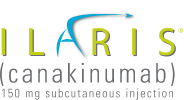What is SJIA?
Systemic Juvenile Idiopathic Arthritis (SJIA) is an autoinflammatory disorder which can be caused by having too much of or being too sensitive to certain proteins, including IL-1β, and can lead to symptoms such as fever, rash, headache, feeling very tired (fatigue), or painful joints and muscles. SJIA is a type of Still's disease.
What causes SJIA?
SJIA is an idiopathic disease, which means that its cause is unknown. What is known about SJIA is that it's an autoinflammatory disease, meaning that it causes the body's immune system to attack healthy cells, leading to the signs and symptoms of SJIA.
How long will my child have SJIA?
It can vary. Your child may need to undergo SJIA treatment for a period of several years or more. But with treatment, children with SJIA can experience symptom improvement as time passes.
What is the difference between a localized and a systemic symptom?
As opposed to localized symptoms, such as pain in certain joints, systemic symptoms can affect the body as a whole. For example, a systemic symptom of SJIA is fever.
What will happen to my child with SJIA?
SJIA affects every child differently. The disease cycle swings back and forth between symptom-free periods and flares, or times when the symptoms worsen. Some children with SJIA only get one cycle of symptoms, and others will have a chronic course of ups and downs. Learn about SJIA treatment options.
What is ILARIS?
ILARIS® is a prescription medication that is FDA approved to treat Still's disease, including SJIA in patients 2 years and older. ILARIS works by attaching to and blocking interleukin-1 beta (IL-1β), a type of cytokine responsible for inflammation. For SJIA, ILARIS is given once a month as a subcutaneous injection right below the skin.
How can ILARIS help with active SJIA?
ILARIS can help relieve SJIA symptoms, including fevers (systemic) and painful and/or swollen joints (arthritic). In addition, some children receiving ILARIS were able to reduce or stop taking corticosteroids altogether. For SJIA, ILARIS is given by a doctor or nurse as a once-monthly injection right below the skin. Talk to your doctor to find out if ILARIS may be a treatment option for your child.
How fast does ILARIS work?
190 children were entered into clinical studies to determine the impact of ILARIS on SJIA symptoms. 15 days after their first dose of ILARIS, approximately 8 out of 10 children taking ILARIS experienced improvement in active SJIA symptoms, such as fever and painful and/or swollen joints. None of the children taking ILARIS had fever by day 3 after the first dose.
Is ILARIS given intravenously?
ILARIS is not given as an intravenous infusion (infused inside a vein over a period of time). Instead, it is given as a subcutaneous (right under the skin) injection, or shot, by a doctor or nurse.
How often will my child receive ILARIS?
For SJIA, ILARIS is given as a once-monthly injection. A home health nurse can be sent to your home to administer ILARIS to your child. If you are eligible, this service and other ILARIS support options may be available for you and your child.
Is support available to help us pay for ILARIS?
We're committed to helping you get access to ILARIS. Our ILARIS Companion representatives are here to help by working with your doctor or your child's doctor, and:
-
Contacting your insurance company
-
Verifying insurance benefits and investigation of coverage
-
Addressing coverage issues
-
Navigating prior authorization and appeals, if needed
-
Providing co-pay* assistance for eligible patients with commercial insurance
-
Providing information about alternative assistance options for uninsured patients
*Limitations apply. Please contact ILARIS Companion at 866-972-8315 for more information.
Whom should I speak to if I have more questions about ILARIS?
Talk to your child's pediatric rheumatologist or other healthcare professional. Your child's active SJIA treatment team can consist of many important members. Make sure that you find a doctor that you and your child are both comfortable with.
11/23 307063




